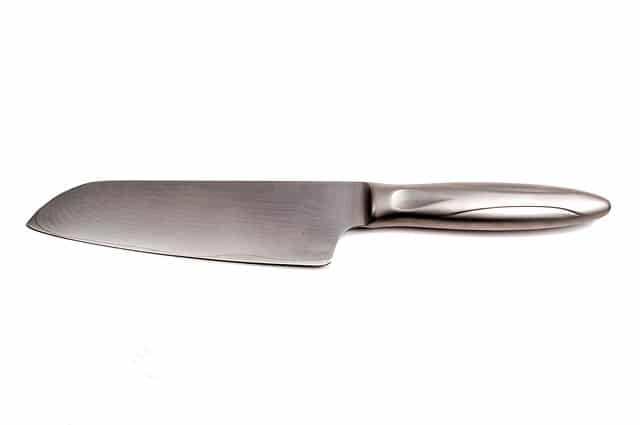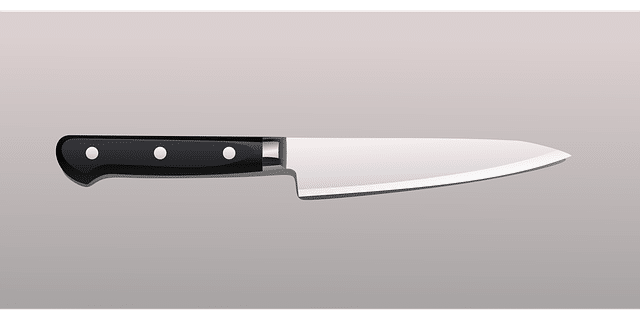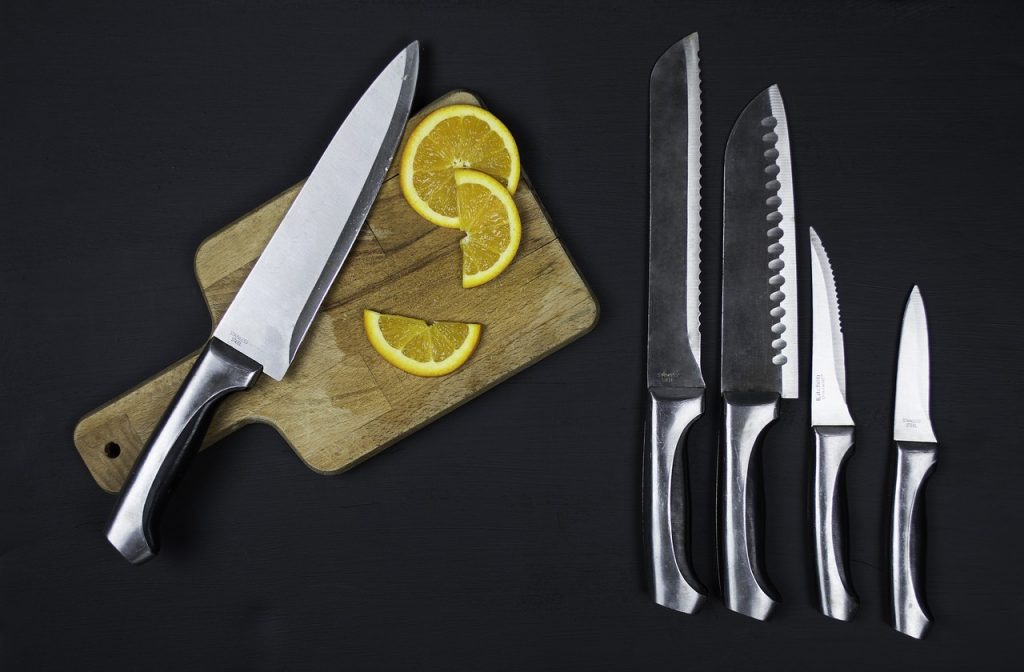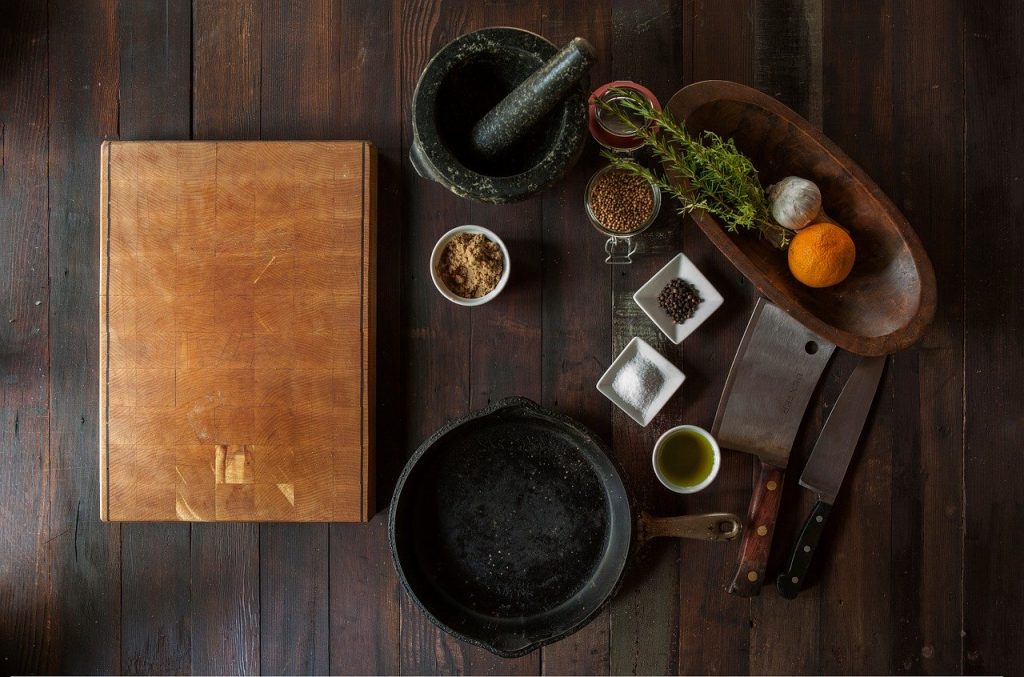Santoku knives, a close competition to the multipurpose chefs’ knife (a.k.a gyuto in case of Japanese knives), have recently shot to fame with many celebrity chefs like Rachel Ray and Giada de Laurentiis absolutely gushing over them. Santoku knives are best for three types of basic chopping needs in any kitchen – slicing, chopping, and dicing.
Unlike the more well-known chefs’ knife, the Santoku knife has a thinner but harder blade, generally made of stainless steel or high carbon steel. These are a little shorter (8 inches) compared to standard chefs’ knives (10 inches) making them perfect for people with smaller hands. A Santoku knife is well balanced and has scalloped edges that keep cut pieces of fruits and vegetables from sticking to the blade.
Table of Contents
Short History of the Santoku Knife
Santoku knives have roots embedded in the Japanese culture and had originally been designed to be used by Japanese housewives. The name loosely translated to “3 uses”- slicing, chopping and dicing.
The knife takes after the more traditional vegetable cleaver, also known as the Nakiri, making it easier to handle the alternative. The cleaver had straight edges, while the Santoku was designed to have a more curved appearance, especially at the tip which resembles a sheep’s foot, leading to a softer tip.

Appearance and Size of Santoku Knives
A standard Santoku knife is 5-8 inches long. It has a curved front with a gentle tip that reduces the chances of accidentally piercing something other than the product being cut. Most Santoku knives have a scalloped cutting edge that prevents food from sticking onto the blade.
The cutting edge of a Santoku knife is almost straight compared to the more curved cutting edge of a regular chefs’ knife. It has a thinner blade allowing more refined slices. The blade is wider (almost like a cleaver), making it scoop up chopped or sliced vegetables.

Uses of Santoku Knives
As the translation of the word ‘Santoku’ suggests, the Santoku knife is good for dicing, chopping, and slicing. The thinner blade in these knives facilitates better slicing. The knives can be used for cutting meat, slicing vegetables, slicing cheese, chopping vegetables and fruits, mincing herbs, mincing meats, etc.
A Santoku is faster and more efficient compared to a chefs’ knife thanks to the straight cutting edge. In a chefs’ knife the cutting edge curves slightly upwards towards the tip, soliciting a rocking motion of the knife to complete one full cut. The straight cutting edge of the santoku allows a complete cut in just one straight downwards motion.
The Santoku has a single cutting edge( a.k.a bevel). The single bevel blade can be sharpened up to a much smaller angle of up to 15 degrees, giving you a much sharper blade. This sharper bevel gives you superior cutting ability. Often, Santoku knives do not have a bolster, allowing you to get a better grip on the heel of the blade.
The wider blade also helps to keep your fingertips and knuckles safe during fast operation. The knife is well balanced and lighter, making it even easier to use. A traditional Santoku knife, however, is made of Japanese steel which tends to be heavier.
Japanese Knives
Traditional Japanese knife makers are some of the most skilled workers in the world. Even to this day, numerous professional chefs prefer hand-made Japanese knives over mass-produced machine-made knives due to their quality and precision. There are over 20 different types of Japanese knives being produced. These knives tend to have handles made of natural materials like wood, with the handle covering the tang (extension of the blade) completely.
Since most Japanese knives are hand made, every single knife tends to be unique. Some blacksmiths prefer to give the blade an uneven hammered finish to keep food from sticking on to the blade. Best quality metal like high-quality Damascus steel is also used by many. Japanese Santoku knives made by well-known blacksmiths tend to sell for over 300 dollars a piece in countries like the United States of America.
What is a Santoku Knife best used for?
Santoku knife is great for multiple purposes but is designed in such a way that it delivers very clean, and refined slices every time. The single bevel cutting edge can be sharpened to a very small angle of up to 15 degrees, making the edge absolutely sharp for thin slicing.
How is a Santoku knife different from a Chef Knife?
| Chefs’ Knife | Santoku Knife |
| 10 inches blade- standard | 8 inches blade- standard |
| Partially exposed tang | Completely concealed tang |
| Mostly double bevel edge | Usually single bevel edge |
| Prominent and sharp tip. | Gentle and less prominent tip. |

FAQs on Santoku Knives
Are Santoku knives good for cutting meat?
Santoku knives would do a good chop of slicing meat. While it can also chop meat thanks to its sharp blades, mincing with a santoku is not advisable since it could damage the blade.
In fact, there a knife separately made for the sole purpose of mincing and that should be used. Any other knife, while can get the job done, will have to bear a lot of damage which can make the cutting edge dull or even cause chipping of the blade in certain cases.What knives do chefs prefer?
The knife a professional chef chooses to use also depends on what function the chef would want the knife to perform. The go-to knife for a chef in most cases would either be a chefs’ knife or a Santoku for the sole reason that they are multipurpose.
There are no hard and fast rules regarding which one of the two a chef would choose since it all depends on the chef’s personal preference.What size Santoku knife should I get?
The size of any knife you choose to use is not based on anything other than personal preference.
It all depends on how the knife feels in your hands. For people with smaller hands, it might be difficult to have complete control over a larger blade which might result in cuts and knicks. There is no shame or harm in going for a smaller blade since your safety and comfort is the top priority.
The size would also be dependent on what kind of tasks you choose to do with the blade. If you wish to cut through harder products like bones with the knife then you might want to go towards medium to long blade lengths.Are Santoku knives any good?
Santoku knives are multipurpose, with superior slicing ability being their biggest plus point. These knives have really sharp edges with a gently tip keeping you from making no accidental cuts and incisions.
Their wider blade helps keep your knuckles away from the edge and also makes for a bigger scooping surface for when you want to move your processed vegetables.
While it might seem that a Santoku knife is more fitting for a professional chef, keep in mind that it was originally designed for a housewife. The design has not changed much ever since and still continues to used by housewives and home cooks all over Japan. It is safer, faster and gives cleaner cuts. Like any other knife, a Santoku also requires sharpening from time to time, but this can easily be taken care of. It is also lighter, necessitating very little effort from you while you use it.


